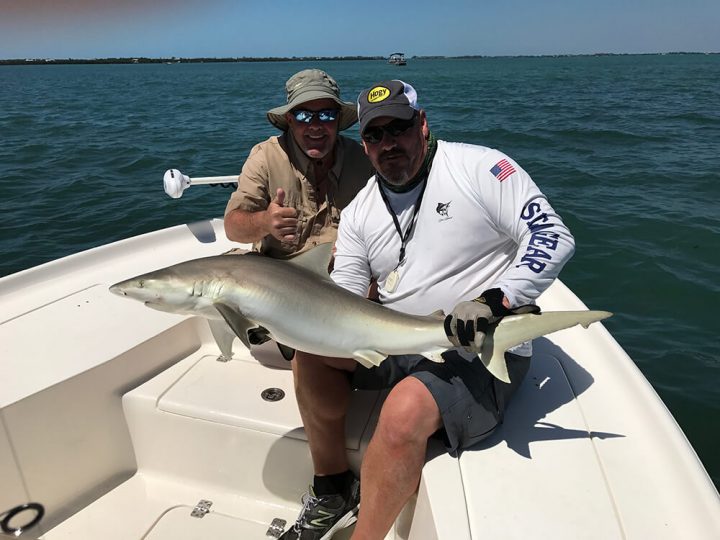
The Gulf Coast of Florida is mainly a very shallow water fishery. We have excellent offshore opportunities in the Gulf for many species like Cobia, Kings, and Tuna. The problem for me as an inshore guide is the winter winds often prohibit any offshore trips so I always need a plan B if the inshore bite is slow.
Plan B for me is to target our smaller Blacktip, Spinner, and Finetooth sharks on the inshore flats of Charlotte Harbor. Aside from our Tarpon, Goliath’s and the occasional monster Snook, there is no other fish that will test your tackle and strength like a 5’ Blacktip peeling line when they feel the sting of the hook. On many charters we fish for Red’s, Snook and Trout in the morning and then set up for sharks to round out a great day on the water. The set up is rather simple and a few techniques will help you enjoy this prolific fishery. One thing you should understand that setting up for sharks is not a guarantee and I tell my clients to expect some boredom with moments of excitement and often a little terror involved.
Gear –
I use my older Tarpon spinning rods outfitted with an 8’ Shimano Teramar rod and #80 Quantum Cabo reels spooled with #50 braid. I like a 3’ 200lb steel leader with a 9/0 J-hook. A longer steel leader can impose some issues with dragging alongside your gunnels, etc. I tie a balloon directly to the line about a foot above the leader to suspend my chunk bait from bottom dwellers like Sail Cats and Puffers.
Bait –
Start out with a chum bag from Baitmasters. Then I always have cut Ladyfish, Jacks, and Mullet. You can never have enough so keep your bait cooler well stocked.
Location –
This is the critical component to success. First of all look for depths in the 4’-6’ range close to a deeper channel or pass if possible. The sharks will run these deeper cuts and find your slick if it is set up properly.
Technique –
Deploy your bow anchor and refrain from using your Power Pole or Talon as I have found them to always be in the way when fighting a shark. You can use the ball float technique to quickly release the anchor if a larger shark happens to take the bait and you need to chase it down. The most important factor is to have the wind and tide flowing in the same direction. If not your chum slick will simply stay with the boat and you won’t have a long slick to attack any toothy critters. Once your chum block has thawed out and you have a nice slick behind the boat I start to toss chunks of cut bait directly by the balloon. Be patient as it may take up to an hour for sharks to zero in on your set up. I always bring two rods, but only keep one in the water. The second rod is used as a pitch rod if you sight a shark circling your balloon, but won’t take the bait. Often a fresh chunk tossed at them will get the battle going.
Landing the Shark –
We generally release all sharks we catch and of course having a client take a picture is magic when they show it off to their friends. Put on some gloves and clear the deck. I take a dock line and tail wrap the shark with it tied off to a side cleat. Once the fish is somewhat subdued I simply grab it from the top of its head behind the gills and sling it on board. A few quick pics and off they go back in the water. Just exercise caution of course and count all your fingers and toes once the fish is swimming away. Be ready as they often come in packs and the next toss of the bait can start the excitement all over again.
Capt. John Curry
capefishing.net
Jtcurry77@gmail.com
(508)-209-7741
